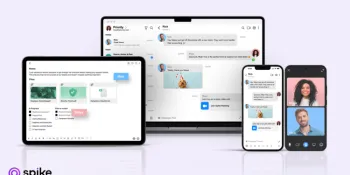Brainwriting: A Fresh Approach to Team Creativity

Picture a team brimming with ideas, yet only a few voices manage to break through the noise in meetings. The loudest personalities dominate, and other valuable ideas go unheard.
Sound familiar? According to research, traditional brainstorming often leads to just that—a few individuals taking the spotlight while many great ideas go untapped.
To tackle this, teams are turning to Brainwriting, a modern approach that ensures all ideas are heard. Everyone writes down their thoughts, and then the team shares and builds on each other’s ideas.
With the right tools, like Spike Teamspace, Brainwriting becomes effortless, whether your team is in the same room or working remotely.
What Is Brainwriting?
Brainwriting is an innovative way for teams to generate new ideas. Team members write their thoughts individually instead of speaking up in a meeting, which affords a comfortable space for everyone to share, including quieter voices.
Once all ideas are recorded, the team shares and discusses them together. This focus on writing promotes more creative thinking and leads to better, more diverse solutions. For example, in a marketing team brainstorming a new campaign, Brainwriting can bring out unique perspectives that may not surface in a traditional discussion.
The Evolution of Brainwriting: From Past to Present
Brainwriting’s structured, inclusive approach to idea generation has deep roots, offering a solution to traditional brainstorming’s common pitfalls.
It began as a way to improve brainstorming sessions, which often allowed only a few people to dominate conversations, leaving others without a chance to share. To address this, brainwriting encourages everyone to write down their ideas.
Over time, brainwriting has evolved to fit how we work today. Teams now leverage digital tools to brainstorm collaboratively, even when working remotely. These adaptations have made brainwriting a versatile tool for fostering creativity and innovation in various work settings.
The 3 Types of Brainwriting
Brainwriting comes in different styles, each designed to spark creativity and collaboration. Here are three popular techniques:
-
6-3-5 Brainwriting: The classic approach
Imagine six people, each writing down three ideas. They pass their paper to the next person, who adds three more ideas. After five rounds, everyone contributed to many different ideas.
This method is excellent for generating many ideas quickly and encourages diverse input. For instance, a product development team might use this method to brainstorm features for a new app.
-
Collaborative brainwriting: Real-time teamwork
In this approach, teams work together on a shared document or platform. Everyone can add their ideas simultaneously, building on each other’s thoughts.
This is a great way to get everyone involved and create a sense of shared ownership, fostering a collaborative spirit. Visualize a design team working together in real time to iterate on creative concepts for a campaign.
-
Remote brainwriting: Flexible and asynchronous
Brainwriting can be done online for teams that work remotely. Team members share their ideas through a digital platform, allowing for flexible participation and asynchronous collaboration.
This technique is ideal for distributed teams, supporting thoughtful input without time constraints. For example, a global team working across different time zones can contribute to a project without being hindered by scheduling conflicts.
Whatever technique you choose, the key to successful brainwriting is to create a safe and supportive environment where everyone feels comfortable sharing their ideas, allowing creativity to flourish.
How to Apply Brainwriting in Your Team
Now that you understand Brainwriting’s basics, let’s dive into how to implement it effectively. Here’s a practical guide to get your team started:
1. Preparation
- Set clear goals: Clearly define the purpose of the brainwriting session. Are you brainstorming new product ideas, solving a specific problem, or planning a strategy? Ensure everyone understands the objective of aligning efforts.
- Choose the correct format: Select a brainwriting technique that best suits your team’s needs and work environment. Consider the 6-3-5 method for generating many ideas quickly or collaborative brainwriting for real-time interaction.
- Create a comfortable space: Set up a physical or virtual space where participants feel comfortable. A quiet room or a well-organized digital platform fosters creativity and focus.
2. Running the session
- Assign roles: Designate a facilitator to guide the session and ensure everyone participates.
- Set time limits: Establish clear time limits for each round to maintain momentum.
- Encourage anonymity: Anonymizing submissions can reduce bias and encourage honest, uninhibited feedback.
3. Sharing and building on ideas
- Review collectively: Once everyone has shared their ideas, review them as a group. Encourage participants to build on each other’s thoughts and look for synergies.
- Prioritize ideas: Select the most promising ideas using a voting system or other prioritization techniques.
- Assign action steps: Clearly define the next steps for each prioritized idea and assign responsible individuals to maintain accountability.
4. Overcoming challenges
- Resistance to change: Introduce brainwriting gradually and highlight its benefits. To build confidence, share examples of how other teams have successfully implemented it.
- Dominant personalities: Consider anonymizing submissions or using structured time limits to ensure balanced participation.
- Lack of creativity: Use techniques like mind mapping, warm-up exercises, or pre-session brainstorming prompts to spark creativity before starting brainwriting.
Remember, the key to successful brainwriting is to create a safe and supportive environment where everyone feels comfortable sharing their ideas. By following these guidelines, your team can harness the power of brainwriting to boost creativity and innovation.
How Spike Helps Implement Brainwriting

Implementing brainwriting successfully requires the right tools, and that’s where Spike comes in. Spike Teamspace is designed to help teams collaborate seamlessly, making it easy to apply brainwriting techniques in any setting.
Why Spike is perfect for brainwriting:
- Asynchronous participation: Spike lets teams work together from anywhere at any time. This is great for brainwriting, as everyone can share their ideas at their own pace.
- Organized workspace: Spike keeps everything organized. Using Spike Notes, you can write down ideas, share them with the team, and track progress all in one place.
- Task management and follow-up: Spike helps you turn ideas into action. You can assign tasks, set deadlines, and follow up on progress.
Wrap-up
Brainwriting is an excellent way for teams to develop new ideas, promoting inclusivity and diverse thinking. Spike makes it easy to brainstorm, no matter where your team is. With Spike, you can share ideas, track progress, and turn those ideas into actual plans.
Try Spike today and see how it can boost your team’s creativity. Are you ready to transform your brainstorming sessions and elevate your team’s innovation?




